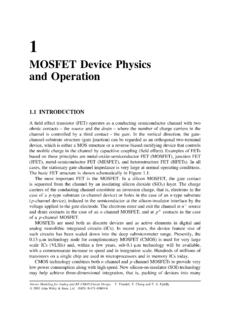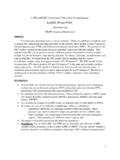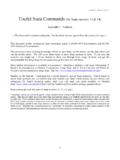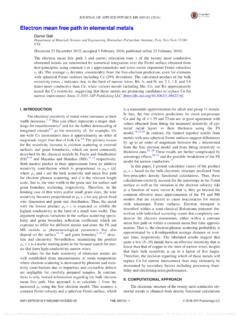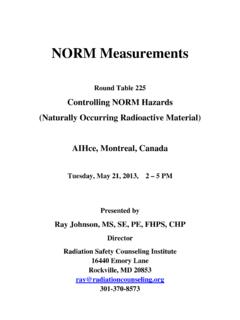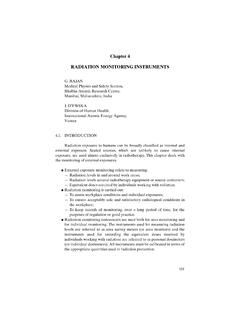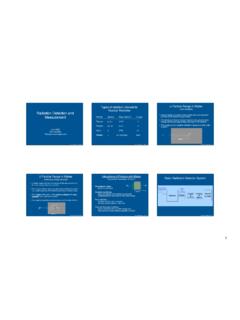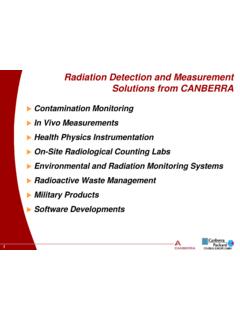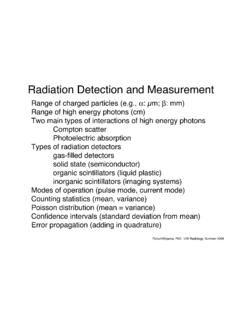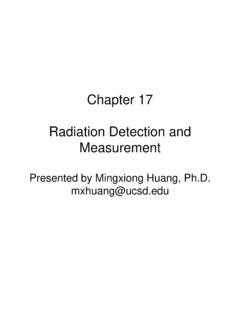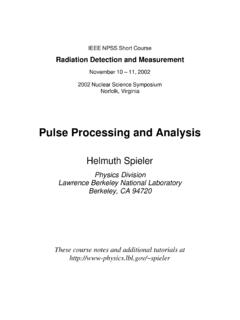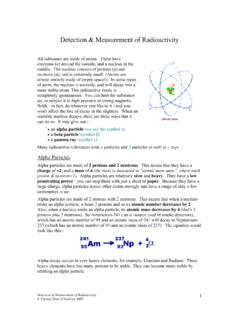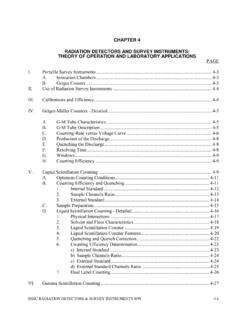Transcription of Advances in Radiation Detection and Measurement
1 505 Transactions of the American Nuclear Society, Vol. 113, Washington, , November 8 12, 2015 Transactions of the American Nuclear Society, Vol. 113, Washington, , November 8 12, 2015 Advances in Radiation Detection and MeasurementA Real-Time Personal Neutron Dosimeter using Microstructured Solid-State Neutron Detectors A. Weltz, I. Bhat, R. Dahal, and Y. Danon Rensselaer Polytechnic Institute (RPI) Troy, NY 12180 110 8th St. Troy, NY 12180 INTRODUCTION Neutron dosimetry involves the process of employing a neutron Detection system in the presence of neutrons in order to determine the localized neutron dose rate, which is measured as the neutron dose equivalent in units of Sieverts/second (mrem/hour).
2 A number of passive dosimeters have been widely used for personal neutron dosimetry, including: the solid-state track detector, the film badge, the neutron bubble dosimeter, and the thermo-luminescent dosimeter (TLD) [1]. These dosimeters are passive instruments because they do not provide any immediate feedback. Instead, these passive dosimeters are worn for a set period of time and are subsequently analyzed in order to determine the integrated personal neutron dose equivalent for the period which they were worn to ensure that the user does not exceed their annual dose limits.
3 The need for a real-time, personal neutron dosimeter prompted the development of a commercially-available real-time neutron dosimeter which uses two solid-state diodes coated with a single layer of thermal and fast neutron converting materials, respectively [2, 3]. The low efficiency of planar solid-state detectors limits the sensitivity of such a dosimeter. The conception and recent improvements to microstructure solid-state neutron detectors enable the development of a real-time personal neutron dosimeter with improved sensitivity.
4 Microstructured Solid-State Neutron Detectors Microstructured solid-state thermal neutron detectors have been developed by a number of research groups [4, 5, 6]. These solid-state neutron detectors as opposed to their gas-filled counterparts are compact, light-weight, require no bias voltage, and are easier to embed in various moderator configurations. The solid-state devices developed for the real-time personal neutron dosimeter presented here were fabricated within RPI s Micro and Nano Fabrication Clean Room.
5 These devices are heterogeneous detectors since they are composed of two distinct regions: a neutron converting region which serves to convert neutrons into directly-ionizing charged particles and a semiconductor region which serves to collect charge produced by the daughter ions. The detectors have demonstrated very low leakage current density (~ A/cm2at -1 V for a mm2device), a -discrimination ratio better than the PNNL recommendation for a well-designed neutron detector (10-6 for a 10 mR/hr exposure rate from a 60Co source),and scalability to large surface areas [7, 8].
6 The real-time personal dosimeter implements both thermal and fast microstructured devices. The thermal detector was fabricated by creating a repeated microstructure of deep, hexagonal holes on a silicon (Si) wafer using deep reactive ion etching (DRIE). This pattern produces a microscopic honeycomb pattern, and the hexagonal holes are filled with boron (enriched to 93% 10B) using chemical vapor deposition (CVD). Aschematic of the honeycomb detector developed at RPI can be seen by Figure 1.
7 The neutron absorption reaction of 10 Bused to detect thermal neutrons can be seen in Equation 1. This device produces a detectable signal when a neutron is absorbed by 10B and the daughter ions escape the boron-filled region, depositing their residual energy in the charge-collecting Si region. Figure 1. Schematic of the honeycomb solid-state thermal neutron detector developed at RPI. 510+ 94% : (0. 84 + ( .47 24376% : ( .02 + 37 ( .78 24 (1) The fast neutron detector utilizes a repeated microstructure of long and narrow trenches, which are similarly etched into a Si wafer using DRIE.))))
8 The trenches are filled with parylene, which was used because of its high hydrogen content. This device is designed to induce proton recoil reactions in the hydrogenous parylene in the presence of fast neutrons. Recoiled protons escape the parylene-filled trenches and deposit their residual energy in the Si-region, producing electron-hole pairs which are collected by sputtered metal contacts. Subsequent 506 Transactions of the American Nuclear Society, Vol. 113, Washington, , November 8 12, 2015 Advances in Radiation Detection and Measurementpreamplification, pulse shaping, and analog-to-digital conversion allow for the pulses to be identified as neutron events if the pulse height is above the electronic noise level.
9 NEUTRON DOSIMETER DESIGN A well-designed neutron dosimeter has an energy-dependent neutron respose which is proportional to the ambient dose equivalent conversion factors reported inInternational Commission on Radiological Protection (ICRP) Publication 21 and 74 (Figure 2).These factors provide flux-to-dose conversion factors for neutrons of a wide energy range. A neutron dosimeter which has an energy-dependent response that is proportional to the flux-to-dose conversion factors has an ideal rem response and can accurately predict the neutron dose equivalent for the corresponding neutron energy 2.
10 The neutron flux-to-dose equivalent conversion factors from ICRP Publications 21 (1973) and ICRP 74 (1996). DOSIMETER SIMULATION AND DESIGN The real-time personal neutron dosimeter was designed using using Monte Carlo N-Particle Code [9] with the goal of achieving an energy-dependent response which matches the shape of the ideal rem response while maintaining adequate sensitivity and remaining compact enough to be worn on the simulations were created in order to model the fast and thermal microstructured detectors.
